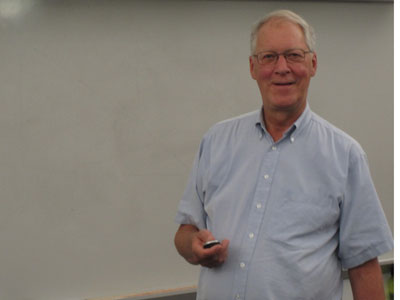With development on the rise around the world and the metals that allow it to occur in short supply, new sources must be found to satisfy demand. The sources suggested by Dr. Steve Scott from the University of Toronto are seafloor massive sulfides (SMS), the study of which he has pioneered for decades.
Scott was the first mining geologist to examine black smoker geothermal vents, which are the source of SMS deposits. During the lecture, he explained how the vents form and why they are so mineral rich. In parts of the ocean, seawater permeates the seafloor, and is heated by magma just beneath the surface causing minerals and metals from the surrounding rock to dissolve. When the hot water passes back up through the seafloor and contacts the ambient cold water, sulfides precipitate, forming black clouds of material and chimney-like spires. Said Scott, “The spires grow and they fall down, new spires grow and they fall down, and eventually you have a massive sulfide.” The process is helped along by frequent seismic activity found in these areas of sulfide-friendly geothermal activity.
One such location is near Papua New Guinea in the Manus Basin of the Bismarck Sea. Discovered in 1997 by Scott and Ray Binns of CSIRO Australia, this location called Solwara 1 is the closest of any SMS deposit to actually being mined. The rights to the 0.11 square kilometer, 1600 meter deep site are owned by Nautilus Minerals, which plans to use robots to excavate the mineral formation by scraping off layers at a time and pumping them to the surface. The process is expected to begin in 2013.
Marine mining requires no infrastructure, poses little risk to miners, and creates no waste rock. Instead of being underground in tunnels, “Miners and engineers will sit on air conditioned ships, and pilot the robots,” said Scott. He added, “Nobody lives on the sea floor, so there are not social repercussions.” These benefits combined with potentially higher yields than many geologically similar land mines might make marine mining a better option, but it is not without serious problems.
Chief among these problems is potential damage to black smoker ecosystems. Scott mentioned that focus may be shifting away from extinct black smokers to ones that are more active. Each black smoker ecosystem supports a unique cast of creatures which are frequently one of a kind. Powerful mining robots could easily destroy ecosystems which may be the only known examples on the planet. As with any mining operation, careful environmental study must be performed to ensure minimal impact.
It remains to be seen whether SMS mining will take off and become a major source of metals and resources like Scott has suggested it can. Risks associated with mining the ocean floor may be too great to justify actually doing it. That being said, there is still undeniable mineral wealth to be found there – undeniable wealth recognized by a different person in a different time. Scott concluded his lecture with a quote. “…In the ocean depths, there are mines of zinc, iron, silver, and gold that would be quite easy to exploit.” The author of the quote was Jules Verne, and the year was 1870. Now, 140 years later, it is possible to actually do it.



'Van Tuyl lecture seafloor massive sulfide mining' has no comments
Be the first to comment this post!